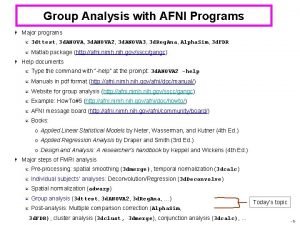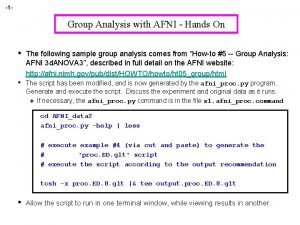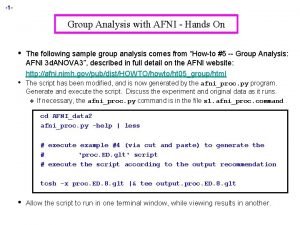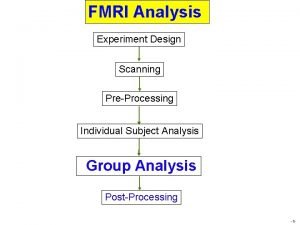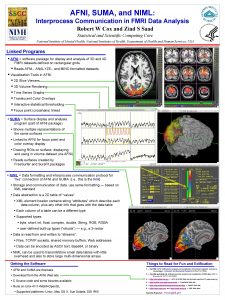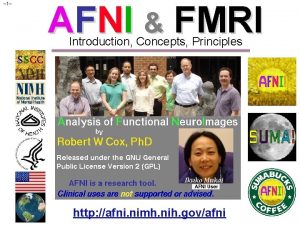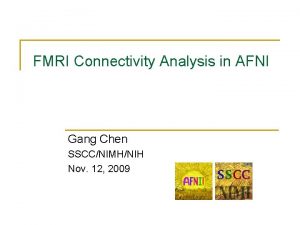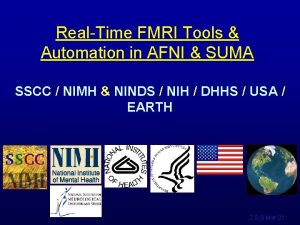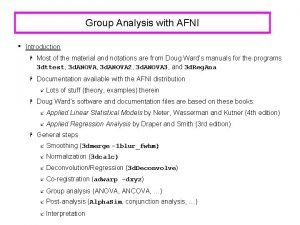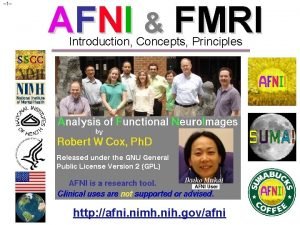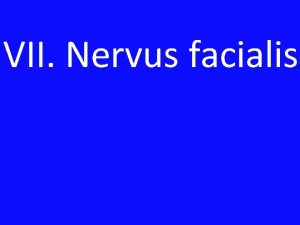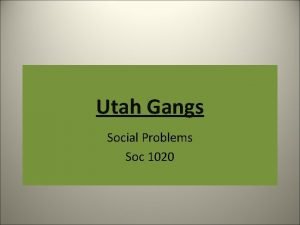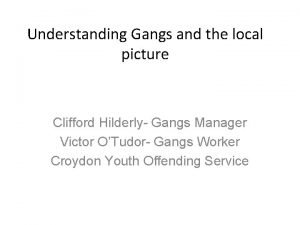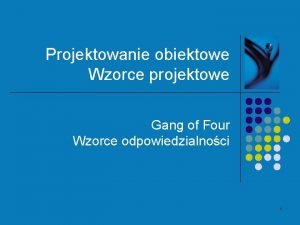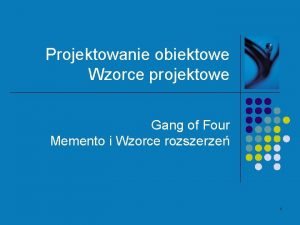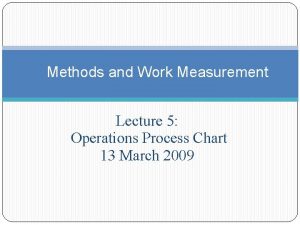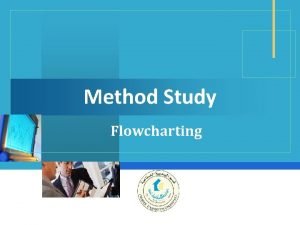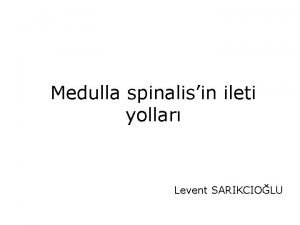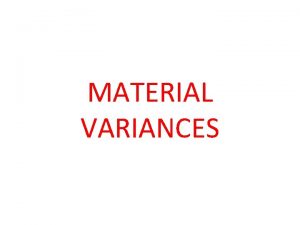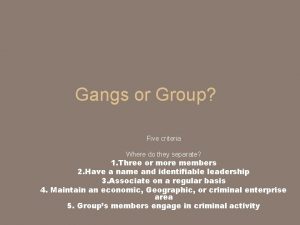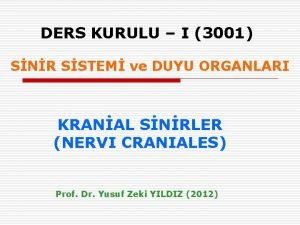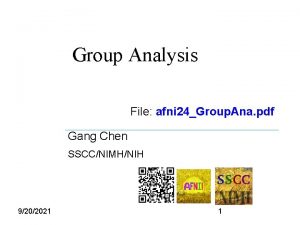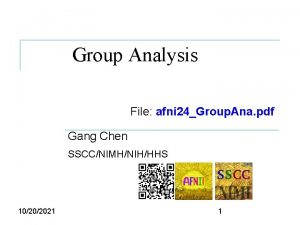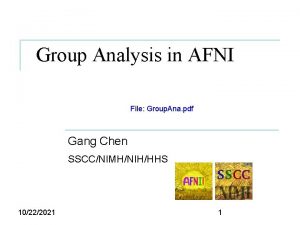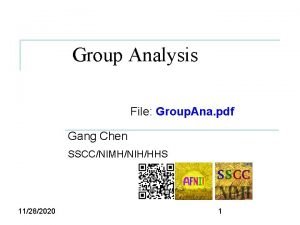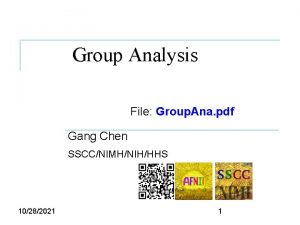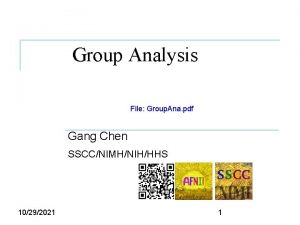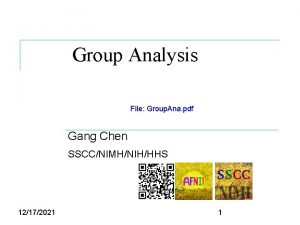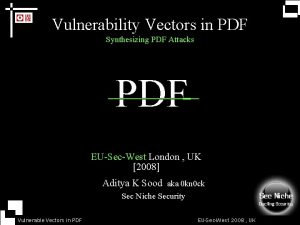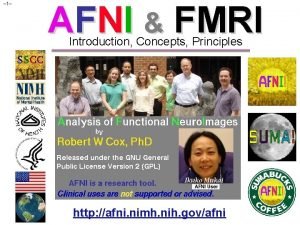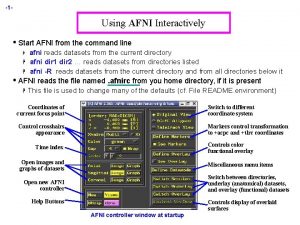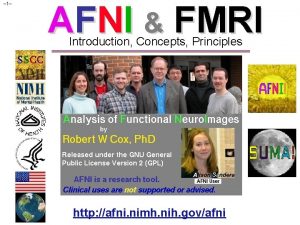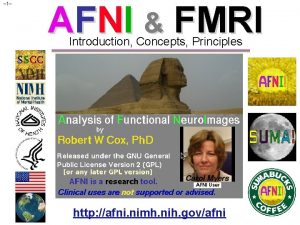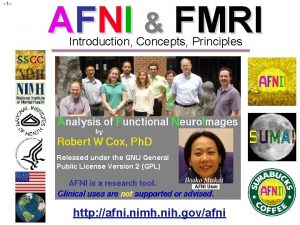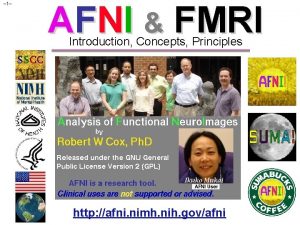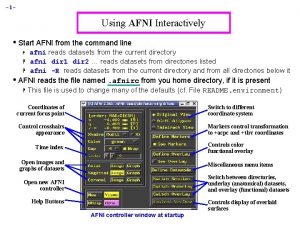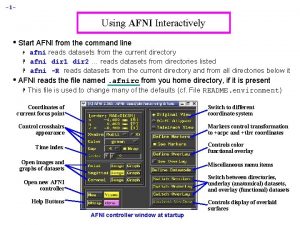Group Analysis File afni 24Group Ana pdf Gang






































- Slides: 38

Group Analysis File: afni 24_Group. Ana. pdf Gang Chen SSCC/NIMH/NIH/DHHS/USA/Earth

Program List • 3 dttest++ (GLM: one-, two-sample, paired t, between-subjects variables) • 3 d. MVM (generic AN(C)OVA) • 3 d. LME (sophisticated cases: missing data, within-subject covariates) • 3 d. MEMA (similar to 3 dttest++: measurement errors) • 3 d. ANOVA (one-way between-subject) • 3 d. ANOVA 2 (one-way within-subject, 2 -way between-subjects) • 3 d. ANOVA 3 (2 -way within-subject and mixed, 3 -way between-subjects) • 3 dttest (obsolete: one-sample, two-sample and paired t) • 3 d. Reg. Ana (obsolete: regression/correlation, covariates) • Group. Ana (obsolete: up to four-way ANOVA) • 3 d. ICC (intraclass correlation): prototype only • 3 d. ISC (intersubject correlation): prototype only -2 -

Preview of Coming Attractions • Concepts and terminology • Group analysis approaches o o GLM: 3 dttest++, 3 d. MEMA GLM, ANOVA, ANCOVA: 3 d. MVM LME: 3 d. LME Presumed vs. estimated HDR (i. e. , fixed vs. variable shape) • Miscellaneous o o o Issues with covariates Intra-Class Correlation (ICC) Inter-Subject Correlation (ISC) Goal = Give outline of AFNI capabilities in group analyses Decisions about complex situations require help https: //afni. nimh. nih. gov/afni/community/board -3 -

Why Group Analysis? • Reproducibility and generalization o Summarization o Generalization: from current results to population level o Typically 10 or more subjects per group o Individualized inferences: pre-surgical planning, lie detection, … • One model combining both steps (single subject and group)? o + Ideal: less information loss, more accurate inferences o - Historical o - Computationally unmanageable, and very hard to set up o - Data quality check at individual level -4 -

Simplest case • BOLD responses from a group of 20 subjects data: (β 1, β 2, …, β 20)=(1. 13, 0. 87, …, 0. 72) o mean: 0. 92 o standard deviation of the betas: 0. 40 or. 90 o Do we have strong evidence for the effect being nonzero? o • Statistical modeling perspective o Simplest GLM: one-sample t-test Statistical evidence - t-test: o summarization: b (dimensional), sd, and t (dimensionless) o -5 -

Terminology • Response/outcome variable: left-hand side of model Regression βi coefficients (plus measurement errors) o Structured: subjects, tasks, groups o • Explanatory variables: right-hand side of model Categorical (factors) vs quantitative (covariates) o Fixed- vs random-effects: conventional statistics o • Type of Models Univariate GLM: Student’s t-tests, regression, AN(C)OVA o Multivariate GLM: within-subject factors o LME: linear mixed-effects model o MEMA: mixed-effects multilevel analysis o BML (Bayesian multilevel model) o -6 -

Terminology: categorical vs quantitative • Factors Finite (small) number of levels: categories (coded by labels) o Within-subject (repeated-measures): tasks, conditions o Between-subjects o § § o patients/controls, genotypes, scanners/sites, handedness, … Each subject nested within a group Subjects: random-effects factor - measuring randomness § Of no intrinsic interest: random samples from a population • Quantitative variables numeric or continuous o age, IQ, reaction time, brain volume, … o 3 usages of “covariate” o No interest: § Qualitative (e. g. , scanner/site, groups) § Quantitative (e. g. , per subject amount of head motion) § Explanatory variable (e. g. , subject age, anxiety score) § -7 -

Terminology: fixed vs random • Fixed-effects variables o Of research interest § § o Modeled as constants, not random variables § o Visual vs auditory, age, … Unable to extend to something else Shared by all subjects Not exchangeable/replaceable or extendable to something else • Random-effects variables (mean + random part) o Of research interest? § § Subjects: random samples Trials, regions? Modeled as random variables: Gaussian distributions o Exchangeable, replaceable, generalizable o • Differentiations blurred under BML (Bayesian Multi-Level) -8 -


Terminology: interactions • Interaction effect between 2 or more factors o Omnibus: overall inference or summarization § § § o Conventional ANOVA framework F-statistic: not detailed enough to tell what specifically is happening Further partitions: post hoc inferences via pairwise comparisons 2 × 2 design: difference of difference § F-test for 2 x 2 interaction = t-test of (A 1 B 1 - A 1 B 2) - (A 2 B 1 - A 2 B 2) or (A 1 B 1 - A 2 B 1) - (A 1 B 2 - A 2 B 2) -10 -

Terminology • Interaction effect involving a quantitative variable o By default: linearity (age, modulation, …) § § o Controlling: misconception – e. g. , “covary out” age differences? or, Effect of interest Interaction between a factor and a quantitative variable -11 -

Terminology • Interaction effect involving a quantitative variable o Validity of linearity of b with (e. g. ) age § Nonlinear: difficult (too much freedom)! Polynomials? Theory-driven? -12 -

Example: 2 × 3 Mixed ANCOVA • Explanatory variables o o Factor A (Group): 2 levels (patient and control) Factor B (Condition): 3 levels (pos, neg, neu – emotional words) Factor S (Subject): 15 ASD children and 15 healthy controls Quantitative covariate: Age • Piecemeal: multiple t-tests – too tedious o o o Group comparison + age effect Pairwise comparisons among three conditions § Assumption: same age effect across conditions Difficulties with t-tests § Main effect of Condition: 3 levels plus age? § Interaction between Group and Condition § Age effect across three conditions? -13 -

Classical ANOVA: 2 × 3 Mixed ANOVA (no covariate) o Factor A (Group): 2 levels (patient and control) o Factor B (Condition): 3 levels (pos, neg, neu) o Factor S (Subject): 15 ASD children and 15 healthy controls o Covariate (Age): cannot be modeled; no correction for sphericity violation Different denominators 3 d. ANOVA 3 –type 5 (equal # of subjects across groups) -14 -

Univariate GLM: 2 x 3 mixed ANOVA o Group: 2 levels (patient and control) o Condition: 3 levels (pos, neg, neu) o Subject: 3 ASD children and 3 healthy controls b X Difficult to incorporate covariates • Broken orthogonality of matrix No correction for sphericity violation a d -15 -

Univariate GLM: problematic implementations (in some other software we won’t name) Two-way mixed ANOVA Between-subjects Factor A (Group): 2 levels (patient, control) Within-subject Factor B (Condition): 3 levels (pos, neg, neu) 1) Omnibus tests Correct Incorrect 2) Post hoc tests (contrasts) - Incorrect t-tests for factor A due to incorrect denominator - Incorrect t-tests for factor B or interaction effect AB when weights do not add up to 0 -16 -

Univariate GLM: problematic implementations Two-way repeated-measures ANOVA Within-subjects Factor A (Object): 2 levels (house, face) Within-subject Factor B (Condition): 3 levels (pos, neg, neu) 1) Omnibus tests Correct Incorrect 2) Post hoc tests (contrasts) - Incorrect t-tests for both factors A and B due to incorrect denominator - Incorrect t-tests for interaction effect AB if weights don’t add up to 0 -17 -

Better Approach: Multivariate GLM o Group: 2 levels (patient and control) o Condition: 3 levels (pos, neg, neu) o Subject: 3 ASD children and 3 healthy controls o Age: quantitative covariate Βn×m = Xn×q Aq×m + Dn×m B B Data = betas X A D Model = Design matrix = Main Effect & Group Coding & Covariate Fit Parameters (to be computed) Residuals -18 -

MVM Implementation in AFNI • Program 3 d. MVM – generalize multi-way ANCOVA, and more o No dummy coding needed! o Symbolic coding for variables and post hoc testing Variable types Post hoc tests Data layout

MVM General Linear Tests – besides main effects o Symbolic coding for variables and post hoc testing o o o -bs. VARS ‘Grp*Age’ shows 2 between subjects variables o -q. Vars ‘Age’ shows one is quantitative (numbers) o So the other one Grp is categorical (labels) o -ws. Vars ‘Cond’ shows 1 within subjects variable (categorical) o Potential values for all variables collated from data table GLT #3 “Grp : 1*Pat Cond : 1*Pos -1*Neg” o Within the Grp variable, select the Pat mean effect o Within the Cond variable, select the difference between the Pos and Neg mean effects o Age is not specified, so test will be carried out on the effects regressed to the Age center (for each Grp) GLT #4 “Grp : 1*Pat Age : ” tests the slope of the betas w. r. t. Age for Patients (averaged across Cond values)

Improvement 1: precision information • Conventional approach: βs as response variable o Assumptions § § o no measurement errors all subjects have same precision All subjects are treated equally (have the same randomness) • More precise method: estimated βs plus precision estimates o o o t-statistic contains precision (t = β / SEM(β) ) βs and their t-stats as input βs weighted based on precision Only available for simple GLM types: 3 d. MEMA Regions with substantial cross-subject variability • Best approach: combining all subjects in one big super-model o Currently not feasible -21 -

One group: Example • 3 dttest++: β as input only 3 dttest++ –prefix Vis -mask+tlrc -zskip -set. A ‘FP+tlrc[Vrel#0_Coef]’ ’FR+tlrc[Vrel#0_Coef]’ …… Voxel value = 0 treated it as missing ’GM+tlrc[Vrel#0_Coef]’ • 3 d. MEMA: β and t-statistic as input 3 d. MEMA –prefix Vis. MEMA -mask+tlrc -set. A Vis FP ’FP+tlrc[Vrel#0_Coef]’ ’FP+tlrc[Vrel#0_Tstat]’ FR ’FR+tlrc[Vrel#0_Coef]’ ’FR+tlrc[Vrel#0_Tstat]’ …… GM ’GM+tlrc[Vrel#0_Coef]’ ’GM+tlrc[Vrel#0_Tstat]’ -missing_data 0 Voxel value = 0 treated it as missing -22 -

Paired comparison: Example • 3 dttest++: comparing two conditions 3 dttest++ –prefix Vis_Aud -mask+tlrc –paired -zskip -set. A ’FP+tlrc[Vrel#0_Coef]’ ’FR+tlrc[Vrel#0_Coef]’ …… ’GM+tlrc[Vrel#0_Coef]’ -set. B ’FP+tlrc[Arel#0_Coef]’ ’FR+tlrc[Arel#0_Coef]’ …… ’GM+tlrc[Arel#0_Coef]’ -23 -

Paired Comparison: Example • 3 d. MEMA: accounting for differential accuracy (among βs) o Contrast as input 3 d. MEMA –prefix Vis_Aud_MEMA -mask+tlrc -missing_data 0 -set. A Vis-Aud FP ’FP+tlrc[Vrel-Arel#0_Coef]’ ’FP+tlrc[Vrel-Arel#0_Tstat]’ FR ’FR+tlrc[Vrel-Arel#0_Coef]’ ’FR+tlrc[Vrel-Arel#0_Tstat]‘ …… GM ’GM+tlrc[Vrel-Arel#0_Coef]’’GM+tlrc[Vrel-Arel#0_Tstat]’ -24 -


Improvement 2: more accurate HDR • Group analysis with HDR estimates: TENTzero, CSPLINzero o NHST: H 0: β 1=0, β 2=0, …, βk=0 [all responses in HRF = zero] o Area under curve (AUC) approach o § Reduce HRF to one number: use area as magnitude approximation § Ignore shape subtleties § Shape information loss: (undershoot, peak location/width) Better approach: maintaining shape integrity § Take individual βs to group analysis (MVM) § One group with one condition: 3 d. LME § Other scenarios: treat βs as levels of a factor (e. g. , Time) - 3 d. MVM ** Task or group effect: F-stat for interaction between task group and Time, complemented with main effect for task/group (AUC) Chen et al. (2015). Detecting the subtle shape differences in hemodynamic responses at the group level. Front. Neurosci. , 26 October 2015. -26 -

Improvement 2: more accurate HDR • 2 groups (children, adults), 2 conditions (congruent, incongruent), 1 quantitative covariate (age) • 2 methods: HRF modeled by 10 (tents) and 3 (SPMG 3) bases • Effect of interaction: interaction group: condition – 3 d. MVM -27 -

Improvement 2: more accurate HDR • Advantages of ESM over FSM o o More likely to detect HDR shape subtleties Visual verification of HDR signature shape (vs. relying significance testing: p-values) Study: Adults/Children with Congruent/Incongruent stimuli (2× 2) -28 -

Dealing with quantitative variables • Reasons to consider a covariate o Effect of interest: variability of response with some subject parameter o Model improvement: accounting for data variability with plausible cause o But you don’t particularly care about this effect per se • Frameworks o ANCOVA: between-subjects factor (e. g. , group) + quantitative variable o Broader frameworks: regression, GLM, MVM, LME, BML o Assumptions: linearity, homogeneity of slopes (interaction) • Interpretations o Effect of interest: slope, rate, marginal effect o Regress/covariate out x? (e. g. , head motion at individual level) o “Controlling x at …”, “holding x constant”: centering -29 -

Quantitative variables: centering • Model o o α 1, α 2 - slope α 0 – intercept: group effect when x=0 Not necessarily meaningful by itself § Linearity may not hold over large ranges of x 1 or x 2 § Centering covariates for interpretability § Mean or median centering? § • When a factor is involved o Complicated decision: within-level or grand centering https: //afni. nimh. nih. gov/pub/dist/doc/htmldoc/STATISTICS/center. html -30 -

A Useful Article about Covariates • • • Miller GM and Chapman JP. Misunderstanding analysis of covariance J Abnormal Psych 110: 40 -48 (2001) http: //dx. doi. org/10. 1037/0021 -843 X. 110. 1. 40 http: //psycnet. apa. org/journals/abn/110/1/40. pdf -31 -

Intra. Class Correlation (ICC) • Reliability (consistency, agreement/reproducibility) across two or more measurements of same/similar condition/task o sessions, scanners, sites, studies, twins o o Classic example (Shrout and Fleiss, 1979): n targets are rated by k raters Relationship with Pearson correlation § § Pearson correlation: two different types of measure: e. g. , BOLD response vs. RT § how much does one measurement type “explain” the other? ICC: same measurement type – how reliable are the results? Modeling frameworks: ANOVA, LME 3 types of ICC: ICC(1, 1), ICC(2, 1), ICC(3, 1) – one-, two-way random- and mixed-effects ANOVA • Whole-brain voxel-level ICC o o ICC(2, 1): 3 d. LME –ICC or 3 d. LME –ICCb 3 d. ICC: ICC(1, 1), ICC(2, 1) and ICC(3, 1) Chen et al. (2017), Human Brain Mapping 39(3) DOI: 10. 1002/hbm. 23909 -32 -

Naturalistic scanning • Subjects view a natural scene during scanning o Visuoauditory movie clip (e. g. , http: //studyforrest. org/) o Music, speech, games, … • Duration: a few minutes (at least) or more • Close to naturalistic settings: minimally manipulated • Effect of interest: intersubject correlation (ISC) – 3 d. Tcorrelate • Calculates correlation coefficient between voxel time series between subjects • Usual input is errts dataset after pre-processing to “correct” for motion, align to template space, et cetera o Extent of synchronization (“entrainment”) o Or of common response in that voxel/region across subjects to whatever they were experiencing • Whole-brain voxel-wise group analysis of these voxel-wise intersubject correlations: 3 d. ISC -33 -

ISC group analysis • Voxel-wise ISC matrix (usually Fisher/arctanh-transformed) o One group o Two groups § Within-group ISC: R 11, R 22 § Inter-group ISC: R 21 § 3 group comparisons: R 11 vs R 22, R 11 vs R 21, R 22 vs R 21 -34 -

Complexity of ISC analysis • 2 ISC values associated with a common subject are correlated with each other: 5 subjects ⇢ 5 x 4/2 = 10 ISC values • i. e. , random fluctuations in inter-subject correlations are correlated • ρ ≠ 0 (unknown) characterizes non-independent relationship • Challenge: how to handle this irregular correlation matrix? -35 -

ISC: LME approach • Modeling via effect partitioning: crossed random-effects LME cross-subject within-subject • Charactering the relatedness among ISCs via LME Chen et al, 2016. Untangling the Relatedness among Correlations, Part II: Inter-Subject Correlation Group Analysis through Linear Mixed-Effects Modeling. Neuroimage. Neuro. Image 147: 825 -840 -36 -

Summary • Concepts and terminology • Group analysis approaches o o GLM: 3 dttest++, 3 d. MEMA GLM, ANOVA, ANCOVA: 3 d. MVM LME: 3 d. LME Presumed vs. estimated HDR • Miscellaneous o o o Issues with covariates Intra-Class Correlation (ICC) Inter-Subject Correlation (ISC) -37 -

Program List • 3 dttest++ (GLM: one-, two-sample, paired t, between-subjects variables) • 3 d. MVM (generic AN(C)OVA) • 3 d. LME (sophisticated cases: missing data, within-subject covariates) • 3 d. MEMA (similar to 3 dttest++: measurement errors) • 3 d. ANOVA (one-way between-subject) • 3 d. ANOVA 2 (one-way within-subject, 2 -way between-subjects) • 3 d. ANOVA 3 (2 -way within-subject and mixed, 3 -way between-subjects) • 3 dttest (obsolete: one-sample, two-sample and paired t) • 3 d. Reg. Ana (obsolete: regression/correlation, covariates) • Group. Ana (obsolete: up to four-way ANOVA) • 3 d. ICC (intraclass correlation): prototype only • 3 d. ISC (intersubject correlation): prototype only -38 -
 Afni group analysis
Afni group analysis Afni group analysis
Afni group analysis Afni group analysis
Afni group analysis Afni group analysis
Afni group analysis File-file yang dibuat oleh user pada jenis file di linux
File-file yang dibuat oleh user pada jenis file di linux Afni suma
Afni suma Afni fmri
Afni fmri Erp afni
Erp afni Afni dimon
Afni dimon What does afni stand for
What does afni stand for Does afni drug test
Does afni drug test Afni fmri
Afni fmri Difference between logical file and physical file
Difference between logical file and physical file Fungsi sistem file
Fungsi sistem file Distributed file system
Distributed file system Markup tag tells the web browser
Markup tag tells the web browser In a file-oriented information system, a transaction file
In a file-oriented information system, a transaction file Management files for
Management files for Pawsome gang
Pawsome gang Gang rules
Gang rules Kornea refleksi siniri
Kornea refleksi siniri Site:slidetodoc.com
Site:slidetodoc.com S block gang
S block gang What gangs are in pueblo colorado
What gangs are in pueblo colorado Wzorce projektowe gang of four
Wzorce projektowe gang of four Wzorce projektowe gang of four
Wzorce projektowe gang of four Pnc gang okc
Pnc gang okc Woodgrange gang
Woodgrange gang Gang process chart
Gang process chart Symbol of storage in method study
Symbol of storage in method study Crus cerebri
Crus cerebri Gang composition variance formula
Gang composition variance formula Kilby street gang colors
Kilby street gang colors Gang-plank
Gang-plank Graffiti symbols meaning
Graffiti symbols meaning Native mob tattoos
Native mob tattoos Gang rules
Gang rules M. dilatator pupillae siniri
M. dilatator pupillae siniri Tiny oriental posse
Tiny oriental posse
